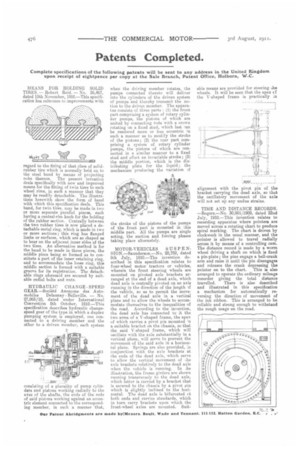Patents Completed.
Page 22

If you've noticed an error in this article please click here to report it so we can fix it.
MEANS FOR HOLDING SOLID TIRES. — Robert Reid. — No. 26,467, dated 15th November, 1910.—This specification has reference to improvements with
regard to the fixing of that class of solidrubber tire which is normally held on to the steel band by means of projecting nobs thereon. The present invention deals specifically with new and improved means for the fitting of twin tires to such wheel rims, in such a manner that they may be readily detachable. The illustrations herewith show the form of band with which this specification deals. This band, for twin tires, may be made in two or more separate parallel pieces, each having a central-rim knob for the holding of the rubber section. Centrally between the two rubber tires is now placed a detachable metal ring, which is made in two or more sections; this ring has flanged limbs or surfaces, which are so shaped BS to boar on the adjacent inner sides of the two tires. An alternative method is for the band to be made in three pieces, the middle piece being so formed as to constitute a. part of the inner retaining ring, and to accommodate the loose ring, this middle section is formed with a suitable groove for its registration. The detachable rings aforesaid are secured by suitable radial bolts and nuts.
HYDRAULIC CHANGE SPEED GEAR.—Societe Anonyme des Auto mobiles Delaunay Belleville. — No. 27,065/10, dated under International Convention 8th October, 1910.—This specification describes hydraulic changespeed gear of the type in which a duplex pumping system is employed, one connected to a driving member and the other to a driven member, each system consisting of a plurality of pump cylinders and pistons working radially to the axes of the shafts, the ends of the rods of said pistons working against an eccentric element connected to the corresponding member, in such a manner that, when the driving member rotates, the pumps connected thereto will deliver into the cylinders of the driven system of pumps and thereby transmit the notion to the driven member. The apparatus consists of three parts : (1) the front part comprising a system of rotary cylinder pumps, the pistons of which are united by connecting rods with a crown rotating on a fixed stud, which last an be rendered more or less eccentric in such a manner as to modify the stroke of the pistons ; 12) the rear part comprising a system of rotary cylinder pumps, the pistons of which are connected in a similar manner to a fixed stud and effect an invariable stroke ; (3) the middle portion, which is the distributing plate for the liquid ; the mechanism producing the variation af the stroke of the pistons of the pumps of the front part is mounted in this middle part. All the pumps are single acting, the suction and forcing phases taking place alternately.
MOTOR-VEHICLES SUSPE NSION.—Saunderaon.—No. 28,752, dated 8th July, 1910.—The invention described in this specification relates to four-wheel motor tractors or vehicles, wherein the front steering wheels are mounted on pivoted axle brackets arranged at the end of a dead axle, which dead axle is centrally pivoted on an axis running in the direction of the length ef the vehicle, so as to permit the movement of the dead axle in a vertical plane and to allow the wheels to accommodate themselves to the inequalities of the road. According to the invention, the dead axle has connected to it the two arms of a V-shaped frame, the apex of which carries a pivot pin mounted 'n a suitable bracket on the chassis, so that the said V-shaped frame, which will oscillate with the axle substantially in a vortical plane, will serve to prevent the movement of the said axle in a horizontal plane. Springs are also provided, in conjunction with the axle brackets at the ends of the dead axle, which serve to allow the vertical movement of ho axle brackets relatively to the dead axle when the vehicle is running. In he illustration, the frame girders are shown running transversely to the dead axle, which latter is carried by a bracket that is secured to the chassis by a pivot pin which is slightly inclined to the horizontal. The dead axle is bifurcated Pt both ends and carries standards, which in turn carry brackets upon which the front-wheel axles are mounted. Suit able means are provided for steering the wheels. It will be seen that the apex a the V-shaped frame is practically :n alignment with the pivot pin of the bracket carrying the dead axle, so that the oscillatory movement of the axle will not set up any undue strains.
TIME AND DISTANCE RECORDS, —Rogers.—No. 30,001/1909, dated 22nd July, 1910.—This invention relates to recording apparatus where pointers are moved across a rotating chart to produce spiral marking. The chart is driven by clockwork in the usual manner, and the pointer is allowed to travel radially across it by means of a controlling cam. The distance record is made by a worm wheel driving a shaft on which is fixed a pin-plate; the pins engage a bell-crank arm and raise it until the pin disengages and releases the crank depressing the pointer on to the chart. This is also arranged to operate the ordinary mileage recorder giving the total distance travelled. There is also described and illustrated in this specification a mechanism for automatically reversing the direction of movement of the ink ribbon. This is arranged to be reliable and strong enough to withstand the rough usage on the road.






















